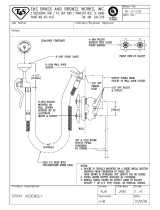
14
Maintenance continued-
Contact your local plumbing supplier or plumbing professional for replacement
parts or contact the company at the address displayed on the rating plate of the
water heater.
For faster and better service, please provide the part name, model, and serial
number(s) of the water heater(s) when ordering parts.
READ THE WARRANTY FOR A FULL EXPLANATION OF THE LENGTH OF
TIME THAT PARTS AND THE WATER HEATER ARE WARRANTED.
Complete the following information and retain for future reference:
Model No:
Serial No:
Service Phone
Days: Nights:
Address:
Supplier:
Supplier Phone No:
Manufactured under one or more of the following U.S. Patents: 5,277,171;
5,341,770; 5,372,185; 5,485,879; 5,574,822; 5,596,952; 5,660,165; 5,682,666;
5,761,379; 5,943,984; 5,954,492; 5,988,117; 6,056,542; 6,142,216; 6,442,178;
6,684,821; 6,935,280; 7,063,132; 7,063,133; 7,007,748; 7,270,087; 7,334,419;
7,337,517; 7,409,925; 7,458,341; 7,559,293; 7,621,238; 7,634,976; 7,650,859;
7,665,210; 7,665,211; 7,699,026; 7,866,168; 7,900,589; 7,971,560; 7,992,526
8,082,888; 8,146,772; Other U.S. and Foreign patent applications pending. Current
Canadian Patents: 2,092,105; 2,107,012; 2,108,186; 2,112,515; 2,143,031;
2,239,007; 2,262,174; 2,314,845; 2,409,271; 2,476,685; 2,504,824; 2,548,958
















